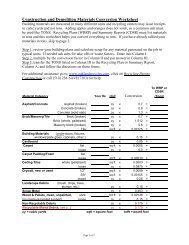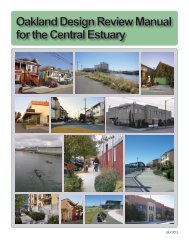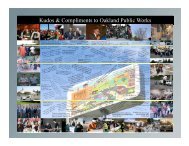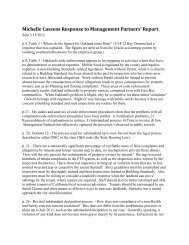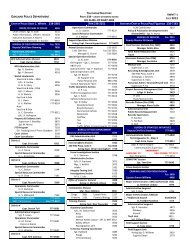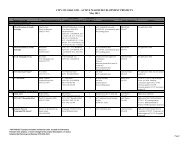Intelligent Transportation Systems - City of Oakland
Intelligent Transportation Systems - City of Oakland
Intelligent Transportation Systems - City of Oakland
You also want an ePaper? Increase the reach of your titles
YUMPU automatically turns print PDFs into web optimized ePapers that Google loves.
In addition to the traffic management and emergency management subsystems, the <strong>City</strong><br />
<strong>of</strong> <strong>Oakland</strong> could also develop parking management and ISP subsystems. These two<br />
efforts, if implemented, would most likely be managed by the <strong>City</strong>’s <strong>Transportation</strong><br />
Services Division and would tie into the <strong>City</strong>’s ATMS.<br />
Two California State agencies, Caltrans District 4 and CHP are an important part <strong>of</strong> the<br />
high-level architecture. Although it is not currently planned, representatives from these<br />
agencies could be located in the <strong>Oakland</strong> TMC during planned events and major<br />
incidents. Since Caltrans District 4 operates the freeway system in the <strong>City</strong> <strong>of</strong> <strong>Oakland</strong>,<br />
it will be important to have a link to Caltrans. This will be accomplished through the<br />
SMART Corridors Program, which will have a direct connection and workstation located<br />
in the Caltrans District 4 TMC. This will allow the <strong>City</strong> <strong>of</strong> <strong>Oakland</strong> to share data with<br />
Caltrans through the SMART Corridors ATMS.<br />
There are other Cities and agencies that should be part <strong>of</strong> the <strong>City</strong> <strong>of</strong> <strong>Oakland</strong>’s ITS data<br />
exchange network. A number <strong>of</strong> agencies will already be connected to the <strong>City</strong> <strong>of</strong><br />
<strong>Oakland</strong> via the East Bay SMART Corridors Program. The neighboring agencies that<br />
will be connected to the SMART Corridor system include <strong>City</strong> <strong>of</strong> San Leandro, <strong>City</strong> <strong>of</strong><br />
Emeryville, <strong>City</strong> <strong>of</strong> Berkeley, Alameda County, AC Transit and Caltrans. The Port <strong>of</strong><br />
<strong>Oakland</strong> has also expressed an interest in sharing information related to traffic<br />
management around the Airport so they should also be part <strong>of</strong> the <strong>City</strong>’s data exchange<br />
network (DEN). In addition, other Cities’ emergency management subsystems could be<br />
coordinated with the <strong>City</strong> <strong>of</strong> <strong>Oakland</strong>’s emergency management subsystems to facilitate<br />
better sharing <strong>of</strong> information during joint incident response. Also, AC Transit, which<br />
serves the transit management function for the <strong>Oakland</strong> area, is an important part <strong>of</strong> the<br />
high-level architecture since AC Transit will need real-time traffic data from the <strong>City</strong> to<br />
better manage their fleet.<br />
There are also regional agencies that are part <strong>of</strong> high-level architecture. The <strong>City</strong> <strong>of</strong><br />
<strong>Oakland</strong> ITS program should coordinate with the MTC 511/TravInfo ® program on major<br />
events or incidents as discussed in Section 4. The 511/TravInfo ® system is the San<br />
Francisco Bay regional ISP managed by the MTC. The 511/TravInfo ® system will<br />
assimilate data gathered from the SMART Corridor (and several other sources<br />
throughout the Bay Area) and disseminate traveler information through a variety <strong>of</strong><br />
media such as a web site, telephone services, cable television, and potentially in-vehicle<br />
devices. Information obtained from other centers in the Bay Area that could affect<br />
operations in the East Bay can be accessed through either the 511/TravInfo ® phone line<br />
or web site. MetroNetworks and other private ISPs also could obtain the travel<br />
information and repackage it for distribution through various outlets that they may <strong>of</strong>fer.<br />
BART is another regional agency that would be included in the <strong>City</strong>’s DEN if the <strong>City</strong><br />
decides to develop its own web site. BART information including schedule changes or<br />
delays would be accessible through a link to the 511/TravInfo ® system.<br />
Finally, one subsystem that wasn’t addressed in the workshop but should be considered<br />
for the <strong>City</strong>’s high-level architecture is the planning subsystem. The <strong>City</strong> <strong>of</strong> <strong>Oakland</strong>’s<br />
ITS data could be made available to the California PATH program in Berkeley or other<br />
universities in the area. PATH and these other universities could conduct research<br />
using the real-time data form the <strong>Oakland</strong> system.<br />
<strong>City</strong> <strong>of</strong> <strong>Oakland</strong> ITS Strategic Plan<br />
60 September, 2003







